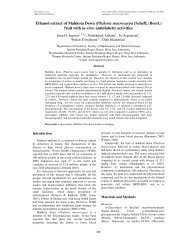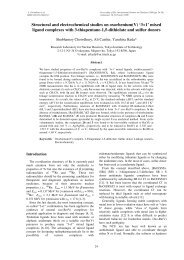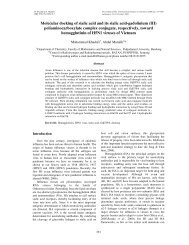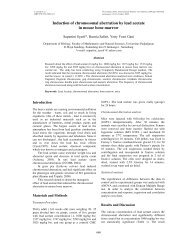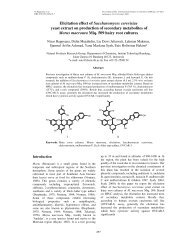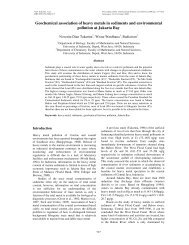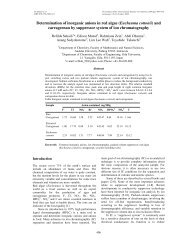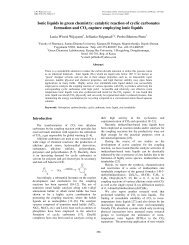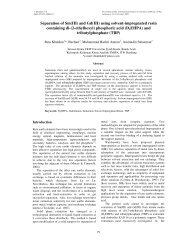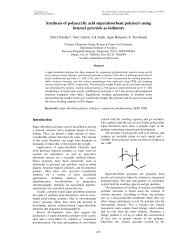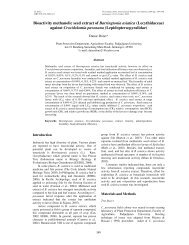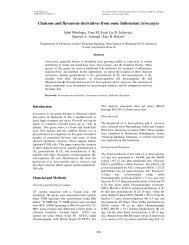Coumarin and steroid compound from stem bark of Kleinhovia ...
Coumarin and steroid compound from stem bark of Kleinhovia ...
Coumarin and steroid compound from stem bark of Kleinhovia ...
Create successful ePaper yourself
Turn your PDF publications into a flip-book with our unique Google optimized e-Paper software.
N.H. Soekamto et al. Proceeding <strong>of</strong> The International Seminar on Chemistry 2008 (pp. 231-234)ISBN 978-979-18962-0-7Jatinangor, 30-31 October 2008<strong>Coumarin</strong> <strong>and</strong> <strong>steroid</strong> <strong>compound</strong> <strong>from</strong> <strong>stem</strong> <strong>bark</strong> <strong>of</strong><strong>Kleinhovia</strong> hospita LinnNunuk H. Soekamto 1 *, Alfian Noor 1 , Iwan Dini 2 , Rudiyansyah 3 , Marry Garson 41 Chemistry Department, Hasanuddin University2 Chemistry Department, Makassar State University3 Chemistry Department, Tanjungpura University4 School <strong>of</strong> Molecular <strong>and</strong> Microdial Science, Quensl<strong>and</strong> University*e-mail: Noek_1512@yahoo.comAbstractA coumarin, 7-hidroxy-6-methoxy coumarin (1) together with β-sitosterol (2) had been isolated forthe first time <strong>from</strong> the chlor<strong>of</strong>orm extract <strong>of</strong> <strong>stem</strong> <strong>bark</strong> <strong>of</strong> <strong>Kleinhovia</strong> hospita L. (Paliasa). Thestructure <strong>of</strong> the <strong>compound</strong> not only were determined on the basis <strong>of</strong> spectroscopic evidence includingIR, 1 H NMR <strong>and</strong> 13 C NMR spectra but also compare with known <strong>compound</strong>.Keywords: <strong>Kleinhovia</strong> hospita L., Sterculiaceae, 6-hidroxy-7-methoxy coumarin, β-sitosterolIntroduction<strong>Kleinhovia</strong> hospita Linn. is a species <strong>of</strong>Sterculiaceae. This species can be found in Indonesia,especially in eastern part <strong>of</strong> Indonesia i.e. in the isl<strong>and</strong><strong>of</strong> Sulawesi, Maluku, <strong>and</strong> Irian, (Heyne, 1987). Thisplant is known locally as Paliasa. It have been usedfor long time in the indigenous sy<strong>stem</strong> <strong>of</strong> medicine <strong>of</strong>Indonesia (especially South Sulawesi) for liver,hepatitis, cholesterol <strong>and</strong> hypertensive. It had beenreported that leave <strong>of</strong> <strong>Kleinhovia</strong> hospita can be usedfor eye wash <strong>and</strong> hair perfume. (Heyne, 1987). InPapua New Gunea <strong>and</strong> Solomon Isl<strong>and</strong>, cambium <strong>of</strong><strong>Kleinhovia</strong> hospita can be used as pneumoniamedicine <strong>and</strong> to kill hairlouse. Leave <strong>of</strong> <strong>Kleinhovia</strong>hospita extract showed antitumor activities in mouseas animal test (Latif, 1997). Beside that, people use<strong>Kleinhovia</strong> hospita plant as construction material.Only few informations on chemical constituents<strong>of</strong> <strong>Kleinhovia</strong> hospita have been known, however, theprevious research identified that there were alkaloid,flavonoid <strong>and</strong> sianogenic <strong>compound</strong>s in <strong>Kleinhovia</strong>hospita which can kill <strong>of</strong>f ectoparasite such as louse(Latif, A., 1997).This paper report the isolation <strong>of</strong> <strong>compound</strong>s <strong>of</strong> <strong>stem</strong><strong>bark</strong> <strong>Kleinhovia</strong> hospita i.e. 7-hidroxy-6-methoxycoumarin (1) together with β-sitosterol (2) <strong>and</strong>biological test fractions <strong>and</strong> <strong>compound</strong>s againstArtemia salina.Material <strong>and</strong> MethodsGeneral Experimental Procedures. Melting pointswere determined on an uncalibrated micro–meltingpoint apparatus. UV <strong>and</strong> IR spectra were measuredwith Cary 100 Conc <strong>and</strong> Perkin Elmer FT–IRspectrophotometers, respectively. VLC was carriedout using Merck silica gel 60 GF 254 , CC with Mercksilica gel 60 (70 <strong>and</strong> 230–400 mesh) <strong>and</strong> TLC onprecoated silica gel plates (Merck Kieselgel 60 GF 254 ,0.25 mm).Plant Material. Samples <strong>of</strong> K. hospita were collectedin January 2005 <strong>from</strong> Tidung Village, RappociniDistrict, Makassar, South Sulawesi, Indonesia. Theplant was identified by the staff <strong>of</strong> the HerbariumBogoriense, Bogor Botanical Garden, Bogor,Indonesia <strong>and</strong> a voucher specimen had been depositedat the Herbarium.Extraction <strong>and</strong> Isolation. The dried powdered leave(4.6 kg) <strong>of</strong> K. hospita was macerated with MeOH, <strong>and</strong>the MeOH extract (5.2 kg), was partitionedsequentially into n-hexane (7.6 g), CHCl 3 (13,1 g) <strong>and</strong>EtOAc-soluble (2.0 g) fractions. The three fractionswere separated by Vacum Liquid Chromatography(VLC) into several fractions. The bioactivity <strong>of</strong> thefractions was tested using brine shrimp (A. salina)(Meyer et. al., 1982) <strong>and</strong> the active fractions weresubjected to VLC <strong>and</strong> repurified using the samemethod yielding two pure <strong>compound</strong>s (1 <strong>and</strong> 2) <strong>from</strong>CHCl 3 fraction. Each <strong>compound</strong> was tested for itsactivity to brine shrimp (Artemia salina).Compounds 1 <strong>and</strong> 2 <strong>from</strong> CHCl 3 fraction wereidentified. Result showed that <strong>compound</strong>s 1 was 7-hidroxy-6-methoxy coumarin <strong>and</strong> 2 was β-sitosterol(Fig. 1). Characteristic <strong>of</strong> the <strong>compound</strong>s aredescribed as follows:Compound 1 was isolated as white powder with m.p.<strong>of</strong> 182-184 o C. UV (MeOH) λ max (log ε): 228 (3.98),344 (4.40) nm; IR (KBr) υ max : 3338 (OH), 2924, <strong>and</strong>2853 (C-H aliphatic), 1701 (C=O), 1608, 1566, 1508,1464 (C=C aromatic), 1376 (CH 3 ), 1291 (C-O) cm -1 ;1 H NMR (Chlor<strong>of</strong>orm-D 6 , 500.2 MHz) δ: 6.27 (1H, d,231
N.H. Soekamto et al. Proceeding <strong>of</strong> The International Seminar on Chemistry 2008 (pp. 231-234)Jatinangor, 30-31 October 2008J = 9.2 Hz, H-3), 7.60 (1H, d, J = 9.2 Hz, H-4), 6.84(1H, s, H-5), 6.92 (1H, s, H-8), 3.95 (3H, s, (OCH 3) );13 C NMR (Chlor<strong>of</strong>orm-D 6 , 500.2 MHz) δ: 161.67 (C-2), 150.41 (C-4’), 149.84 (C-6), 144.16 (C-7), 143.51(C-4), 113.58 (C-3), 111.66 (C-8’), 107.63 (C-5),103.35 (C-8), 56.57 (-OCH 3 ).Compound 2 was isolated as needles white crystal,with m.p. <strong>of</strong> 126 o C. The <strong>compound</strong> did not givephosphorescent under the UV lamp, The IR spectrum<strong>of</strong> 2 exhibited absorptions aliphatic (2956, 2918, 2848cm -1 ), -CH 2 (1462 cm -1 ) <strong>and</strong> -CH 3 (1377cm -1 )groups. The data indicated that <strong>compound</strong> 2 belong toterpenoid derivative. The sugestion was suported bynegatif result in the <strong>steroid</strong> test. 1 H NMR (CDCl 3 ,500.2 MHz) δ: 1.15 ppm (2H, dt, J =11.0; 3.65 Hz, H-1 eq ), 1.08, 1.84, 1.54, 3.51, 2.28, 2.22, 3.51, 1.98,1.94, 1.49, 0.91, 1.48, 2.00, 0.98, 1.58, 1.82, 1.07,1.34, 0.89, 1.65 ppm respectively (1H, m, for H-1 ax ,H-2eq, H-2 ax , H-3, H-4 eq , H-4 ax , H-5, 7eq <strong>and</strong> ax, 8, 9,11, 12eq, H-14, 15 eq , 16, 17, 20, 22 eq , 24, <strong>and</strong> 25 eq ),5.34 ppm (3H, d, J = 4.90 Hz, H-6), 0.67 <strong>and</strong> 1.00ppm (3H, s, H-18 <strong>and</strong> 19), 0.91 ppm (3H, d, J=6.1Hz), 1.14 ppm (2H, m, H-23), 0.82 <strong>and</strong> 0.80 ppmrespectively (3H, d, J = 6.7 Hz, for H-26 <strong>and</strong> 27),1.23 ppm (2H, m, H-28), 0.83 ppm (3H, t; J = 6.7 Hz,H-29); 13 C NMR (CDCl 3 , 500.2 MHz) δ: 140.8 (C-3),121.8 (C-6), 71.9 (C-2), 56.8 (C-15), 56.1 (C-17),50.2 (C-9), 45.9 (C-24), 42.4 (2C C-4 dan 14), 39.8(C-12), 37.3 (C-1), 36.6 (C-20), 36.2 (C-10),34.0 (C-22), 32.0 (2C, C-7 dan 8) 31.7 (C-2), 29.2 (C-25),28.4 (C-16), 26.1 (C-23), 24.4 (C-15), 23.1 (C-28),21.2 (C-11), 19.9 (C-26), 19.5 (C-27), 19.1 (C-19),18.9 (C-21), 12.1 (C-18), 12.0 (C-29).HOH 3 COOOHOH 3 CCH 3CH 3(1) (2)Figure 1 Scopoletin (1) <strong>and</strong> β-sitosterol (2)Results <strong>and</strong> DiscussionA coumarine derivative <strong>compound</strong> which hadbeen isolated for the first time From CHCl 3 fractionwas 7-hidroxy-6-methoxy coumarin (1). This<strong>compound</strong> was purified by coulumn chromatography<strong>and</strong> recrystallization <strong>and</strong> their structure wereH 3 CCH 3CH 3determined by spectral methods <strong>and</strong> comparison withthose reported in the literature.7-hidroxy-6-methoxy coumarin (1) was a whitepowder <strong>compound</strong> with m.p. <strong>of</strong> 182-184 o C. The UVspectrum <strong>of</strong> 1 showed absorption maxima at 228(3.98), 344 (4.40) nm, indicating the presence <strong>of</strong> anextended benzene chromophore. The IR spectrum <strong>of</strong> 1exhibited absorptions for hydroxyl (3338 cm -1 ),aliphatic (2924, <strong>and</strong> 2853 cm -1 ) <strong>and</strong> aromatic (, 1608,1566, 1508, 1464 cm -1 ) groups., -C=O (1701 cm -1 ),CH 3 (1376 cm -1 ), C-O (1291 cm -1 ).UV <strong>and</strong> IR data indicated that <strong>compound</strong> 1 iscoumarine derivative (Murray, et. al., 1982). The 1 HNMR spectrum <strong>of</strong> 1 showed two vinilic proton signalsat δ 6.27 ppm (1H, d, J = 9.2, H-3) <strong>and</strong> 7.60 ppm (1H,d, J = 9.2, H-4). Beside that 1 H NMR spectrum toshow two aromatic proton signals at δ 6.84 <strong>and</strong> 6.92ppm each 1H with multiplicity singlet assignable totetrasubstituted benzena moiety. Another informationin the 1 H NMR spectrum was the signal at δ 3.95 ppm(3H, s) for methyl –OCH 3 .The 13 C NMR spectrum <strong>of</strong> 1, showed that thereare ten signals including C carbonyl (C-2) at δ 161.67ppm, three oxycarbons at δ 144.16, 149.84 <strong>and</strong> 150.41ppm for C-6, C-7, <strong>and</strong> C-8a. And then other carbonatoms i.e. quarterner carbon C-4a, 6, 7, <strong>and</strong> 8a at δ111.66, 144.16, 149.84, <strong>and</strong> 150. 41 respectivelyassigned with the aid <strong>of</strong> HMBC measurements. It canbe proposed <strong>from</strong> these data that the structure <strong>of</strong> 1 is7-hidroxy-6-methoxy coumarin or scopoletin (Fig.2). The HMBC spectrum <strong>of</strong> 1, in particular, disclosedlong-range correlations between four the methynesignals at δ 6.27 ppm (H-3) with carbon signals at δ161.66 ppm (C-2), δ 7.60 ppm (H-4) with carbonsignals at δ 161.66 (C-2), 150.41 ppm (C-8a), δ 6.84ppm (H-5) with carbon signals at δ 149.84 (C-7),150.41 ppm (C-8a), δ 6.92 ppm (H-8) with carbonsignals at δ 144.16 (C-6), 149.84 (C-7), <strong>and</strong> δ 3.95ppm (H-9) with carbon signals at δ 144.16 (C-6) (Fig.3). Further support for structure 1 came <strong>from</strong>comparison <strong>of</strong> the NMR data with that <strong>of</strong> related<strong>compound</strong> (Soekamto et.al., 2001), isolated <strong>from</strong>Morus species (Table 1).Bioassay analysis to the <strong>compound</strong> 1 showmoderate activity against Artemia salina with LC 50 =569,64 µg/mL. Scopoletin was also isolated <strong>from</strong>Morinda citrifolia L. <strong>and</strong> it can be used asantihypertensive, antiinflamatory <strong>and</strong> antiallergenic(Rosa et.al., 2003), <strong>and</strong> can also be used as inhibitorprostagl<strong>and</strong>in synthetase (MH Farah <strong>and</strong> Sauelsson G,1992).232
N.H. Soekamto et al. Proceeding <strong>of</strong> The International Seminar on Chemistry 2008 (pp. 231-234)Jatinangor, 30-31 October 2008H 3 CO3.95 (s)9HO676.84 (s)586.92 (s)4a8a7.60 (d)J = 9.5 Hz4O326.27 (d)J = 9.5 HzOH 3 COHO56.57149.84107.6 143.51144.16 111.66150.41103.35O113.58161.66O(A)(B)Figure 2 Proton signals (A) <strong>and</strong> carbon signals (B) <strong>of</strong> scopoletinHHH 3 COHHOOOHFigure 3 HMBC correlation <strong>of</strong> scopoletinTable 1 1 H-NMR <strong>and</strong> 13 C-NMR data <strong>of</strong> <strong>compound</strong> (1) in CDCl 3 <strong>and</strong> umbeliferon in DMSO (Soekamto, et. al.,2001)No δ C (1) δ C (umbelliferon) δ H (1) δ H (umbelliferon)C1 - - - -2 161.66 160.4 - -3 113.58 111.4 6.27(1H, d, J=9.5)6.27 (1H, d, J=9.5)4 143.51 144.5 7.60 (1H, d, J=9.5) 7.92 (1H, d, J=9.5)4a 111.66 111.2 - -5 107.6 129.7 6.84 (1H, s) 7.51 (1H, d, J=8.5)6 144.16 113.1 - 6.77 (1H, dd, J=2.2& 8.5)7 149.84 161.2 - -8 103.35 102.1 6.92 (1H, s) 6.70 (1H, d, J=2.2)8a 150.41 155.4 - -9 56.57 - 3.95 (3H, s)ConclusionsIn the present investigation 2 <strong>compound</strong>s,scopoletin <strong>and</strong> β-sitosterol had been isolated for thefirst time <strong>from</strong> the chlor<strong>of</strong>orm extract <strong>of</strong> <strong>stem</strong> <strong>bark</strong> <strong>of</strong><strong>Kleinhovia</strong> hospita L. (Paliasa).Scopoletin showed moderate activity to Artemiasalina with LC 50 <strong>of</strong> 569,64 µg/mL. Scopoletin wascan also be used as antihypertensive, antiinflamatory,antiallergenic, <strong>and</strong> inhibitor prostagl<strong>and</strong>in synthetase.AcknowledgementWe thank LIPI Serpong Indonesia for measurementNMR data. We also thank the Herbarium Bogoriense,Bogor, Indonesia, for identification <strong>of</strong> the plantspeciment.233
N.H. Soekamto et al. Proceeding <strong>of</strong> The International Seminar on Chemistry 2008 (pp. 231-234)Jatinangor, 30-31 October 2008ReferenceHeyne, K., (1987), “Tumbuhan Berguna IndonesiaII”, Badan Litbang Kehutanan, Jakarta, hal.659.Latif. A (1997), <strong>Kleinhovia</strong> hospita Linn., In: FaridaHanum & L.J.G. Van Der Maesen. PlantResources in Southeast Asia, No. 11, TheNetherl<strong>and</strong>sMeyer, N., N.R. Ferrigini, J.E. Putnam, D.E.Jacobsen, D.E. Nichols, <strong>and</strong>J.L.McLaughlin (1982), Brine shrimp: A convenientgeneral bioassay for active plant constituens,Planta Med. 45, 31.MH. Farah <strong>and</strong> G. Samuelsson, 1992,Pharmacologicallly active phenylpropanoids<strong>from</strong> Senra incana, (online), diakses 30 April2005, 11.30 AM.Murray, R.D.H., Mendez, J., <strong>and</strong> Brown, S.A.,(1982), “The Natural <strong>Coumarin</strong>s: Occurrence,Chemistry <strong>and</strong> Biochemistry”, John Willey &Sons Ltd.Rosa, Resa dan Wiwit, 2003, Noni dan Royal Jelly,(online),(http://www.pikiranrakyat.com/cetak/1003/18/hikmah/lainnya03htm,diakses 30 April 2005, 11.00 AM).Soekamto, N.H., S.A. Achmad, E.H. Hakim, Y.M.Syah, N. Aimi, M. Kitajima, dan H. Takayama(2001), Umbeliferon senyawa antifungal daritumbuhan Andalas Morus macroura, Bull. Soc.Nat. Prod. Chem. (Indonesia), 1, 13-19.234



